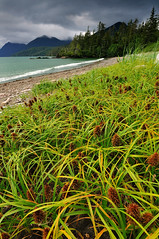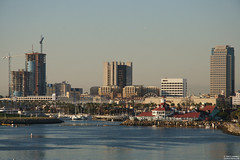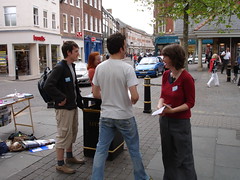Which sidewalk would you rather walk on?
Everytime I drive by a new development I think to myself "why?" Why are they building it like that? Oh, and especially when they are advertising an "urban" lifestyle. Why do they constantly screw it up? Let's think about our cities for a while. Let's discuss first our streets.
What makes someone want to walk on the sidewalk? Accessibility.
Let's perform an autopsy on un-walkable city streets.1.Streets that are 2-4 lanes going each way. That makes 8 lanes to cross (I've seen
10 in Irvine, CA!
Main&MacArthur2a.
No parking curbside.
2b. Sidewalk. sometimes with some trees as a buffer to the street
3. A buffer typically of turf or some shrubs probably rhaphiolepis
4. A
parking lot5. and
THEN the building
Now let's dissect a walkable city street1. Usually 2 lanes going each way making a 4 lane street
2. Parking on the street which creates a buffer between the pedestrians and traffic.
3. Sidewalk again sometimes with trees.
4. Building
Now think about it. Do you want to cross 6-10 lanes? 100 ft? or 4 lanes 40 ft?
When you walk on the sidewalk, would you rather walk along moving cars or parked cars?
Do you want to walk across a parking lot to get to a building or do you want the building's entrance to be a few steps away?
By putting the building entrance along the sidewalk you are forcing people to walk along the sidewalk. Putting the building in the right spot but moving the entrance around does NOT help. Why would I even want to use the sidewalk if the entrance isn't there?
Wouldn't a street front store increase business? There would be heavy foot traffic causing more exposure as opposed to cars whizzing by your store on the other side of the parking lot.
Removing parking lots is a GOOD idea. Increasing street parking is a GOOD idea, and having fewer lanes is a GOOD idea.
Final food for thought, Think of the most famous streets in Los Angeles
County, one of the least walkable metropolitan areas in the country.(remember that song "Nobody walks in LA"?)
Melrose, Sunset, Hollywood, and sometimes Rodeo, Think about it, now go there. You'll see what I'm talking about.
edit* (those streets I mentioned are very walkable hence the mentioning of such, they did it right in those areas)











